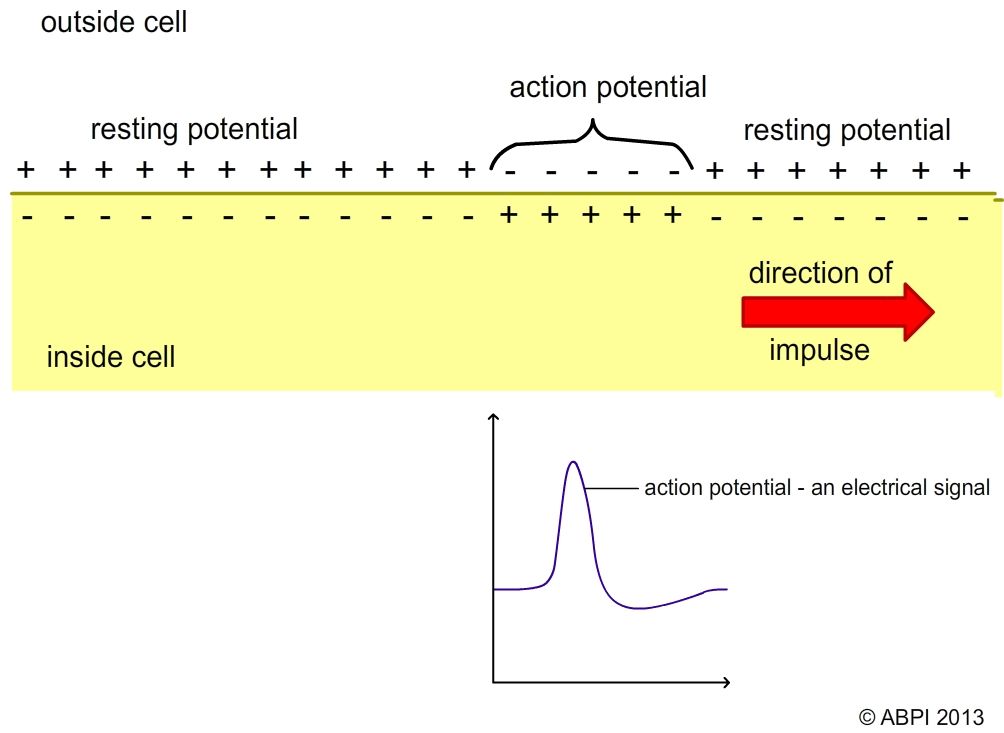This topic takes on average 55 minutes to read.
There are a number of interactive features in this resource:
 Biology
Biology
Your nervous system is a living network of nerve impulses which travel along the neurones of the body all the time. They pass between the cells of the brain as well. Each nerve impulse is a tiny electrical event which passes along the neurone.
How does your body generate all this electricity? A nerve impulse is the result of charge differences across the membrane of the axon. The inside of the axon becomes positive instead of negative compared to the outside of the axon. This change is caused by the movement of charged particles known as ions through the membrane. The wave of positive charge which passes along the inside of an axon when the neurone is stimulated is known as the action potential. As the impulse moves along the neurone, the axon behind it returns to normal.

Although your neurones carry electrical impulses, they are not continuous wires running all around your body. One neurone connects with another. Where one neurone ends and another begins there is a tiny gap known as a synapse. The electrical impulse travelling along a neurone has to cross a synapse to reach the next neurone – but the electrical impulse cannot jump the gap.
When an impulse arrives at the synapse at the end of a neurone, the vesicles move to the membrane.
Synapses contain vesicles (small sacs) which hold special chemicals called neurotransmitters. When an impulse arrives at in the synapse at the end of a neurone, the vesicles move to the membrane. They release their chemicals into the gap. The chemicals cross the synapse and are picked up by special receptors in the end of the next neurone. This in turn starts up a new electrical impulse which travels along the next neurone. This is how impulses are passed from one neurone to another all over your body and in your brain.
If there are any problems with the synapses, it has a major impact on how your body works. For example Parkinson’s disease is caused by a lack of the neurotransmitter dopamine in the brain. Levels of dopamine in the synapses of the affected areas of the brain get lower. As a result, nerve impulses do not pass properly between the neurones. Movements become slower, muscles feel stiffer and less responsive and affected people may develop a tremor (see page 6 for more details on diseases affecting the neurones and CNS).
The importance of neurotransmitters can be seen very clearly when you look at synapses which use a chemical called acetyl choline as their neurotransmitter. A number of well known poisons affect these synapses:
| Poison | Effect on synapse | Effect on the nervous system |
|---|---|---|
| Botulinus toxin | There is no transmission of impulses across the synapse so the nervous stops working causing death. | There is transmission of impulses across the synapse so the nervous stops working causing death. Very low doses used to stop nerve impulses to particular muscles in botox beauty treatments |
| Strychnine and organophosphates | Inactivate the enzymes made by the second membrane in the synapse and stop the breakdown of the acetyl choline that is released | The nerves fire all the time so the muscles contract continuously and the person is rigid and paralysed. |
| Curare (made by poison arrow frogs) | Blocks the receptors on the second membrane of the synapse so it cannot respond to a stimulus | The muscles cannot be stimulated so they cannot contract causing floppy paralysis. |
